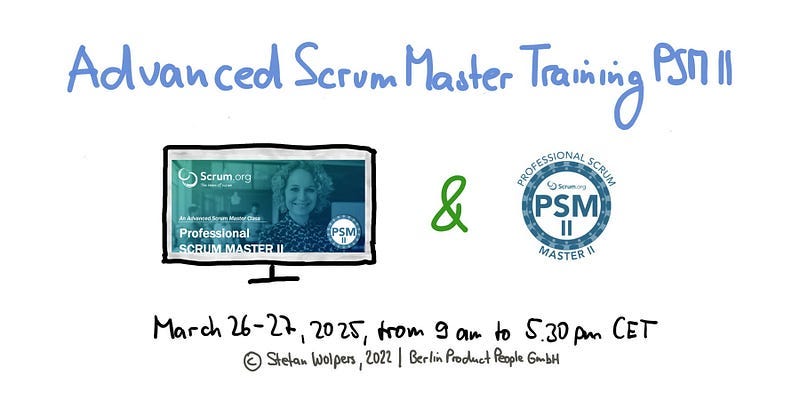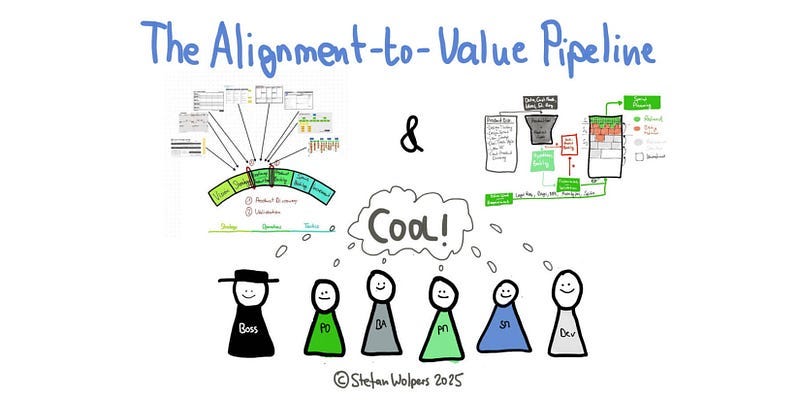Food for Agile Thought #484: Vibe Coding, Product’s Hard Nature, Brittle Product Teams, Pivots & Post-Mortems
Also: Alignment to Value, Reducing Planning, Quitting a FAANG Job, Pilot Projects
Hello everyone!
Welcome to the 484th edition of the Food for Agile Thought newsletter, shared with 42,673 peers.
This week, Ethan Mollick examines vibe coding, where AI-native teams blend human expertise and AI to iterate and collaborate rapidly. Maarten Dalmijn critiques rigid planning, advocating for elastic teams that thrive in complexity. In anticipating engineering’s shift toward AI management roles, Jasper Gilley quit his FAANG job, seeing automation redefine technical careers. Michael Küsters likens middle management to Rock-Paper-Scissors, where unpredictability is key to success. At the same time, Fred Hebert dissects AI integration, emphasizing thoughtful human-in-the-loop design to avoid automation pitfalls. Also, Zvi Mowshowitz unpacks the Manus hype, revealing it as a cleverly marketed Claude wrapper, demonstrating how LLMs and AI hype cycles shape perceptions of capability.
Next, Itamar Gilad argues that product success is rare due to underestimated complexity and misaligned forces, advocating for strategic clarity and intentional culture-building. Then, David Pereira highlights how pilot testing helps PMs validate assumptions, reduce risks, and iterate faster, and Brian Balfour predicts AI will redefine product teams — transforming methodologies, roles, monetization, and distribution — urging AI-native strategies. In an interview with Peter Yang, Anthropic’s Scott White details how Claude 3.7 Sonnet accelerates product development through AI-generated PRDs, evals, and agentic coding tools.
Lastly, we critique overly blameless post-mortems, advocating for balanced accountability to prevent mediocrity, and Johanna Rothman champions rolling-wave planning to reduce pressure and improve adaptability. Ash Maurya stresses that successful pivots require rapid business model testing and external accountability. Additionally, Zvi Mowshowitz dissects Manus, a Chinese AI agent hyped as groundbreaking but revealed as a Claude wrapper, and, finally, Andrew Chen explores “vibe coding,” where AI reshapes software creation, predicting a shift toward intuitive, GUI-driven design, fragmented UX, and adaptive, self-improving applications.
🛑 Becoming obsolete is a choice, not inevitable!
👉 Don’t Miss Out — Join the Second Cohort: AI for Agile Practitioners: Pilot Cohort #2, May 14 to June 11, 2025, at € 199!
Did you miss the previous Food for Agile Thought issue 483?
🏆 The Tip of the Week
Ethan Mollick: Speaking Things Into Existence
Ethan Mollick explores “vibe coding,” demonstrating how AI-native product teams blend human expertise and AI to rapidly prototype, creatively iterate, and dynamically collaborate — reshaping product development in a vibe-filled work environment.
What seems consistent is that, for now, the greatest value comes not from surrendering control entirely to AI or clinging to entirely human workflows, but from finding the right points of collaboration for each specific task — a skill we’re all still learning.
Source: Speaking Things Into Existence
Author: Ethan Mollick
🧠 Artificial Intelligence
(via Honeycomb): AI: Where in the Loop Should Humans Go?
Fred Hebert explores the critical question of where humans fit in AI-driven systems, emphasizing thoughtful integration to avoid automation pitfalls and maintain essential human expertise and situational awareness.
Source: Honeycomb: AI: Where in the Loop Should Humans Go?
Zvi Mowshowitz: The Manus Marketing Madness
Zvi Mowshowitz analyzes Manus, a hyped Chinese AI agent revealed as a cleverly marketed Claude wrapper, highlighting influencer-driven hype and how LLMs plus basic “vibe coding” can quickly simulate advanced capabilities.
Source: The Manus Marketing Madness
Author: Zvi Mowshowitz
Andrew Chen: Vibe coding, some thoughts and predictions
Andrew Chen describes “vibe coding,” an AI-driven coding approach emphasizing intuition over traditional coding, predicting shifts toward youth-created software, GUI-based design, fragmented UX, adaptive self-improving apps, and evolving dev team roles.
Source: Vibe coding, some thoughts and predictions
Author: Andrew Chen
➿ Agile & Leadership
Maarten Dalmijn: Why Most Organizations Produce Brittle Teams Instead of Elastic Teams
Maarten Dalmijn explains that organizations unintentionally create brittle teams by obsessing over predictability and excessive planning, sacrificing adaptability; instead, fostering elastic teams that embrace complexity, flexibility, and short feedback loops produces better results.
Source: Why Most Organizations Produce Brittle Teams Instead of Elastic Teams
Author: Maarten Dalmijn
Michael Küsters: Predictability in middle management? Good luck!
Middle management, as Michael Küsters explains, is a balancing act between stability, performance, and disruption. Success lies in unpredictability — dynamically shifting strategies, avoiding rigid cycles, and staying ahead of inevitable shifts.
Source: Predictability in middle management? Good luck!
Author: Michael Küsters
Jasper: I quit my FAANG job because it’ll be automated by the end of 2025
Jasper Gilley quit his FAANG job, anticipating automation will rapidly reduce engineering roles to “AI context managers” or “infrastructure janitors,” reshaping careers around human skills rather than traditional technical expertise.
Source: I quit my FAANG job because it’ll be automated by the end of 2025
Author: Jasper
🖥 🇬🇧 Advanced Professional Scrum Master Training w/ PSM II Certificate — March 26–27, 2025
Discover Scrum’s four success principles in this official Scrum.org Advanced Scrum Master training class, which includes the industry-recognized PSM II certification. The PSM II training class is designed as a live virtual class and will be in English.
Enjoy the benefits of a live virtual immersive class with like-minded agile peers from 09:00–17:30 CET.
Learn more: 🖥 🇬🇧 Advanced Professional Scrum Master Training w/ PSM II Certificate — March 26–27, 2025.
Customer Voice: “Dear Stefan, Thanks a lot for two intense and mindblowing days. Your way of teaching suites me perfectly. I must admit that all the positive feedback you have gotten is spot on! I would any time a day recommand your class to a Scrum Master who wants to add a whole new level to his/her scrum game. To all of you reading this. You have to experience Stefans class to understand how good it is.” (Source.)
🎯 Product
David Pereira: How Pilot Projects Can Give PMs the Support They Lack from Leadership
David Pereira highlights that pilot testing can bridge the gap between PMs and leadership by quickly converting assumptions into evidence, reducing product risks, enabling faster iteration, and effectively identifying valuable and distracting features.
Source: How Pilot Projects Can Give PMs the Support They Lack from Leadership
Author: David Pereira
Itamar Gilad: Why Is Product So Hard?
Itamar Gilad argues product success is rare because organizations underestimate complexity, fail to align conflicting forces, and neglect culture — emphasizing embracing uncertainty, strategic clarity, and treating organizational culture intentionally as a product.
Source: Why Is Product So Hard?
Author: Itamar Gilad
🎙 Peter Yang: Inside the Best AI Model for Coding and Writing | Scott White (Anthropic)
In Peter Yang’s interview, Anthropic’s Scott White explains using Claude 3.7 Sonnet for efficient, iterative product building through AI-generated PRDs, precise evals, rapid prototyping, cross-team collaboration, and agentic coding tools.
Source: 🎙 Inside the Best AI Model for Coding and Writing | Scott White (Anthropic)
Author: Peter Yang
Brian Balfour (via Reforge): AI Native Product Teams: How They Will Think, Work, and Build Differently
Brian Balfour argues that AI will fundamentally redefine product teams, transforming methodologies, roles, tools, monetization, and distribution, urging teams to embrace AI-native strategies and rethink their entire product approach.
Source: Reforge: AI Native Product Teams: How They Will Think, Work, and Build Differently
Author: Brian Balfour
📯 The Alignment-to-Value Pipeline: Building Products That Matter
Effective product development requires both strategic alignment and healthy Product Backlog management. Misalignment leads to backlog bloat, trust erosion, and building the wrong products. By implementing proper alignment tools, separating discovery from delivery, and maintaining appropriate backlog size (3–6 sprints), teams can build products that truly matter. Success depends on trust, collaboration, risk navigation, and focusing on outcomes over outputs. Learn more about how to embrace the alignment-to-value pipeline and create your product operating model.
Learn more: The Alignment-to-Value Pipeline: Building Products That Matter.
🛠 Concepts, Tools & Measuring
staysaasy: Blameful Post-Mortems
The author argues that overly blameless software post-mortems harm accountability, emphasizing the need for balanced “blameful” practices that clearly assign fault, encourage ownership, and fairly hold teams accountable to prevent sustained mediocrity.
Source: Blameful Post-Mortems
Author: staysaasy
Johanna Rothman: How to Reduce Planning, Deliver More, and Surprisingly, Reduce Pressure
Johanna Rothman recommends reducing planning by adopting rolling-wave approaches that limit detailed planning to short, manageable periods, enabling teams to deliver faster, adapt to reality, build trust, and significantly lower pressure.
Source: How to Reduce Planning, Deliver More, and Surprisingly, Reduce Pressure
Author: Johanna Rothman
Ash Maurya: The Art of the Pivot
Ash Maurya emphasizes successful pivots require quickly stress-testing business models, avoiding random experimentation, maintaining external accountability, and separating founder success from individual idea success to accelerate product building effectively.
Source: The Art of the Pivot
Author: Ash Maurya
📅 Training Classes, Meetups & Events 2025
Upcoming classes and events:
🖥 💯 🇬🇧 March 26–27 — Live Virtual Class: Professional Scrum Master Advanced Training (PSM II; English)
🖥 💯 🇩🇪 April 10 — Live Virtual Class: Professional Product Discovery & Validation Training (PPDV; German)
🖥 🇬🇧 April 24 — Live Virtual Class: Professional Scrum Facilitation Skills Class (PSFS; English)
🖥 🇩🇪 April 29–30 — Live Virtual Class: Professional Scrum Product Owner Training (PSPO I; German)
🖥 💯 🇬🇧 May 14-June 11 — Live Virtual Cohort: AI for Agile Practitioners (English)
🖥 🇩🇪 June 3–4 — Live Virtual Class: Professional Scrum Product Owner Training (PSPO I; German)
👉 See all upcoming classes here
🗞️ Last Week’s Food for Agile Thought Edition
📺 Join 6,000-plus Agile Peers on Youtube
Now available on the Age-of-Product YouTube channel:
Hands-on Agile 2025: Humans Robots Agents: Redesigning Leadership and Organizations in the Age of AI — Jurgen Appelo
Hands-on Agile 2025: Change Questions: The Keys to Implementing Organizational Change that Sustains — Dr. Lynn Kelley
Hands-on Agile 2025: the agile way — Peter Merel
Hands-on Agile 62: From Backlog Manager to Product Manager w/ David Pereira
Hands-on Agile 61: Toyota Kata Coaching for Agile Teams & Transformations with Fortune Buchholtz
Hands-on Agile Extra: How Elon Musk Would Run YOUR Business mit Joe Justice
🎓 Do You Want to Read more like this?
Also:
📅 Join 6,000-plus peers of the Hands-on Agile Meetup group
🐦 Follow me on Twitter and subscribe to my blog, Age of Product
💬 Alternatively, join 20,000-plus peers of the Slack team “Hands-on Agile” for free.








